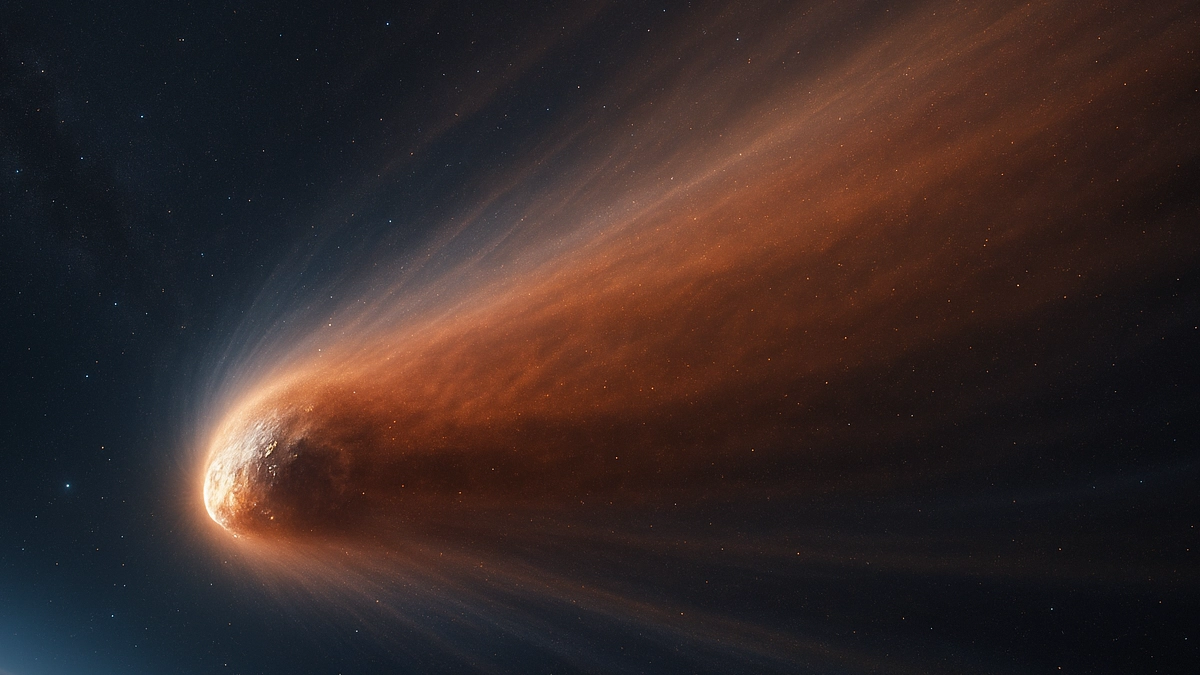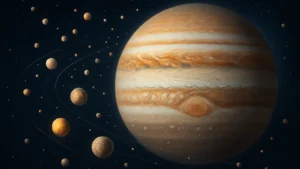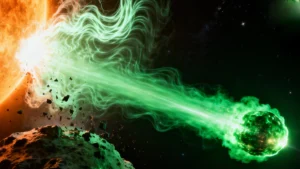The first two interstellar visitors forced a binary narrative: ʻOumuamua as enigmatic and asteroid-like, Borisov as a textbook comet from another star. 3I/ATLAS breaks that mold by combining decisive cometary behavior with an early, coordinated, and instrument-rich observing campaign, shifting the field from reactive puzzling to proactive, system-level science.
Trajectories as fingerprints
- ʻOumuamua’s modest hyperbolic excess and puzzling, low-activity profile blurred its true nature, while Borisov’s extreme eccentricity and vivid activity confirmed an interstellar comet identity.
- 3I/ATLAS arrives fast and unambiguously unbound, discovered inbound with a long lead time and a well-predicted path that includes a favorable perihelion and safe Earth distance, enabling months of targeted observations before and after solar conjunction.
Chemistry resets the baseline
- Borisov’s chemistry looked familiar to Solar System comets but with unusually high CO, hinting at cold formation zones and preserved volatiles.
- 3I/ATLAS shows a chemically rich, active coma with signatures spanning multiple volatile families (e.g., CO2, water-bearing species, CN, and atomic nickel), delivering a multi-dimensional dataset rather than brightness-driven inference.
- This fuller palette connects object chemistry to disk formation zones, migration histories, and cross-system organic delivery, tying small-body science to broader questions in planet formation and galactic habitability.
The observation ecosystem matured
- ʻOumuamua exposed gaps: short lead time, sparse spectroscopy, and a scramble of hypotheses. Borisov improved the cadence but still leaned on opportunistic follow-up.
- 3I/ATLAS is the first interstellar object captured by a planetary-defense survey pipeline and rapidly backstopped by precoveries and multi-agency coordination, proving that distributed networks can act as interstellar early warning and science accelerators.
- The practical payoff is time: space- and ground-based spectroscopy can be scheduled, cross-calibrated, and repeated, turning a rare event into a controlled, comparative experiment.
Mission design implications
- ʻOumuamua inspired fast-intercept concepts but offered no realistic launch window; Borisov motivated feasible trajectories but still demanded urgency and high delta-v.
- 3I/ATLAS’s extended inbound arc, accessible perihelion distance, and predictable post-conjunction return provide a rehearsal ground for launch-on-alert architectures, sensor tasking, and tracking protocols tailored to future ISO intercepts.
- Each well-characterized ISO refines payload priorities. With strong volatile signals, rapid-chase concepts can emphasize high-throughput mass spectrometry and dust compositional analyzers in compact, responsive packages.
Comparative table
| Dimension | ʻOumuamua (1I) | Borisov (2I) | 3I/ATLAS (3I) |
|---|---|---|---|
| Activity | Asteroidal appearance; no clear coma; debated non-gravitational acceleration | Active comet with distinct coma and tail; canonical gas emissions | Active comet; early multi-volatile detections suggest a chemically rich coma |
| Observing window | Short, mostly outbound; ~80 days of intensive scrutiny | Longer inbound and outbound campaigns | Inbound discovery with months of lead time; perihelion near 1–2 au; reappearance after conjunction |
| Excess velocity | Modest; origin ambiguous | High, clearly unbound | Very high, decisively unbound hyperbolic |
| Detection pipeline | Serendipitous; exposed readiness gaps | Improved but still opportunistic | Survey discovery, rapid precovery, and coordinated follow-up by multiple agencies |
Second-order effects across systems
- Planet formation models: Borisov’s CO abundance pushed models toward colder, outer-disk provenance; 3I/ATLAS’s broader volatile mix adds constraints on temperature gradients, irradiation histories, and mixing in protoplanetary disks.
- Survey strategies: The synergy between wide-field surveys and rapid precovery becomes a blueprint for the Rubin/LSST era, where cadence tuning can prioritize hyperbolic inbound candidates and enable earlier classification.
- Public imagination vs. rigor: ʻOumuamua’s ambiguity fueled speculation; a chemically decisive, well-tracked 3I/ATLAS reframes the discourse from “what is it?” to “what does it teach about other planetary systems?”, supporting sustained investment and mission readiness.
Why 3I/ATLAS breaks the mold
- It combines Borisov’s clear cometary identity with a richer, earlier, and more coordinated observation campaign than either predecessor, evolving ISO science from reactive narratives to hypothesis-driven programs.
- Its high-speed, predictable passage and multi-volatile detections provide a scalable template: chemistry baselines, synchronized spectroscopy, and mission rehearsal replace one-off mysteries with cumulative, comparative science.
- The third messenger is not just an object; it is a systems test—of discovery pipelines, observatory coordination, and intercept architectures—raising the readiness level for the next interstellar visitor.
Last Updated on October 18, 2025 by Lucy




